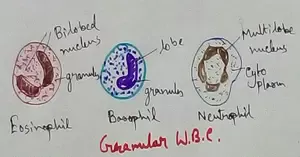Algae
Organisms that belong to plant kingdom, lacking root, stems, leaves having photosynthetic system based on chlorophyll a, their reproductive structures that lack sterile cells are called algae. Prof. F. E. Fritsch is called the father of phycology (study of algae). Algae can be divided into different groups. According to their color algae can be divided into -
1. Green algae - green algae contains chlorophyll a. Thallus in green algae can be divided into – volvocine algae, chlorococcin, tetrasporin line
Chlamydomonas - It is free living aquatic unicellular and flagellate green algae (10-30 micron) that occurs in ammonium rich fresh water. Excessive growth of chlamydomonas causes green color of water. This alga is surrounded by sheath of mucilage, cellulose is absent in cell wall. Palmella stage is observed in presence of toxic chemicals.
Ulothrix – It is unbranched, filamentous green algae of fresh aerated waters which is covered by a thin sheath of mucilage. Lower most cell is colourless and functions as hold fast. Other cells are green, cylindrical appearing rectangular collar shaped having a few pyrenoids around which starch is stored.
Spirogyra – unbranched, filamentous, form floating masses. This green algae form pond scum.It is also called water silk or mermaids tresses. The cells are elongated and cylindrical in shape.
2. Brown algae – Mostly are brown in colour, live in cooler seas. Some are very large they are called trees of seas and kelps. It can be giant (3-60m Maccrocystis), small kelps. Cell wall contains cellulose and phycocolloids. Cell posses chlorophyll a chlorophyll c, fucoxanthine (for brown),other carotenoid. Food reserve in laminarin and mannitol.
3. Red algae - Except for few all others are marine. Unicellular, filamentous to parenchymatous and pseudoparenchymatous form. Cell wall contains cellulose and phycocolloid like agar, food reserved as floridian starch. Chloroplasts (chromatophores) have monothylakoid lamellae. Photosynthetic pigments are chlorophyll a, chlorophyll d, carotenoid, phycobilins (phycoerithrin, phycocyanin etc.). Some alga deposit calcium carbonate on their surface,so they are called coralline algae.E. g. Batrachospermum, Harveyella, Irish Moss, Gloiopeltis, Polysiphonia.
Algae are diverse group of photosynthetic organism which share only a few characteristics. They are-
(i) Algae are Green (presence of chlorophyll), brown (presence of fucoxanthine), and red (presence of phycoerithrin) or color less due to lack of pigments.
(ii) Nonvascular aquatic forms.
(iii) Presence of flagella or may be absent of flagella. According to presence of flagella green algae can be divided into-unicellular flagellate (chlamydomonus), nonflagellate unicellular (Chlorella), flagellate colony (volvox), nonflagellate colony (Hydrodictyon), filamentous (ulothrix), parenchymatous (ulva). Unbranched filamentous alga (Oedogonium).
(iv) Cell wall contains cellulose and phycocolloid.
(v) Chloroplast have 2 - 20 thylakoid lamellae. Pyrenoids occur in the chloroplasts for storage of starch.
(vi) The chloroplasts also contain eye spot in flagellate form.
(vii) Photosynthetic pigments are chlorophyll a, chlorophyll b, carotenes and xanthophylls.
(viii) Asexual reproduction occurs by zoospores (motile spores), aplanospores (thin walled nonflagellate spores), hypnospore (thick walled nonflagellate spores), akinetes (resting cells).
(ix) Sexual reproduction can be isogamy, anisogamy, oogamy.
Questions and answers on Algae:
1. Name the algae that help in development of coral reef?
Coralline help to develop coral reefs in associated with corals.
2. Which algae had antibacterial properties?
Polysiphonia
3. Name some edible algae?
Porphyria, Rhodymenia, Gracilaria, Gelidium etc.
4. Why are red algae famous for yield of agar?
Gelidium, Gracilaria are used as culture medium, stabiliser and thickener.
Recent Articles
-
Formed Elements of Blood | Erythrocytes | ESR |Leukocytes |Neutrophils
Jan 15, 26 01:25 AM
Formed elements formed elements are constitute about 45 % of blood afeias haematocrit value packed cell volume mostly of red blood corpuscles and are of 3 types- erythrocytes, leukocytes and blood pla… -
What Is Plasma? | Blood Plasma | Proteins | Nutrients | Cholesterol
Nov 07, 25 10:29 AM
Blood is a mobile fluid which is a connective tissue and is derived from the mesoderm like cell any other connective tissue. Colour of blood is reddish and that flows inside the blood vessels by means… -
Disorders of Respiratory System | Tuberculosis | Pleurisy | Emphysema
Oct 28, 25 11:39 PM
Tuberculosis is very common disease and is caused by a type of bacteria called Mycobacterium tuberculosis. This disease causes different trouble in the respiration and infection of several parts of th… -
Regulation of Respiration | Respiratory Centres | Inspiratory Area |
Oct 14, 25 12:13 AM
Respiratory Centre is the area that controls the rate of respiration and it is observed to be located in medulla oblongata and pons. Respiratory Centre has the following will dispersed components like… -
Explain Transport of Gases | External Respiration | Tissue Respiration
Oct 09, 25 11:35 PM
In humans gaseous exchange is completed in the following ways the steps are - External Respiration or Breathing - Breathing in false taking in of Oxygen and giving out of carbon dioxide in the body. M…






New! Comments
Have your say about what you just read! Leave me a comment in the box below.